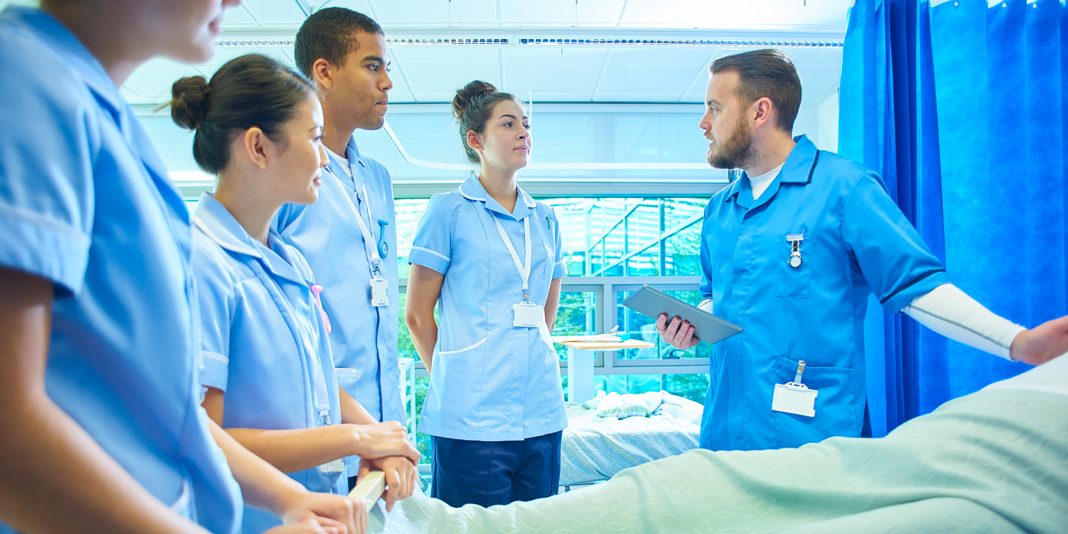Experienced theatre nurses they might have been – but many were still squeamish at the thought of operating on a live pig. The traditional training method for surgeons was new to them but the hands-on opportunity to safely learn about coping with a venal or arterial bleed won them over.
The nurses were part of the first cohort of the new postgraduate programme for registered nurse first surgical assistants (RNFSAs) run by The University
of Auckland and supported by Health Workforce New Zealand (HWNZ).
Thirteen experienced theatre nurses from across the country signed up for the one-year programme that got under way in July last year as a HWNZ innovation project. Twelve of those nurses graduated this spring and while the HWNZ evaluation continues, the initial feedback is good enough for a second cohort to be already waiting in the wings to get under way in February.
Yvonne Morgan, a first surgical assistant and the programme’s clinical co-coordinator is not surprised the demand is there. Her own training as a FSA was prompted after moving into the private hospital sector in 2001 and finding herself increasingly in a de facto FSA role traditionally carried out by doctors in the public sector. “You’d never be allowed to have that role without formal training in the UK,” says the English-trained nurse who came to New Zealand in 1998 with three years of theatre work behind her. Morgan sought out and completed an Australian perioperative nurse surgeon assistant (PNSA) training programme in 2006 and since then has been a self-employed first surgical assistant working across the private and public sectors.
She was also approached by The University of Auckland, that was interested in finding out the potential demand for a FSA programme here. So in 2007-2008, as part of her master’s thesis, she surveyed the College of Surgeons and was “astounded” at the surgeons’ level of support for the advanced nursing role.
Work began on developing a programme and word of mouth had filled the first cohort last year with private sector nurses before HWNZ stepped in to support the programme as an innovation project and nurses from Auckland District Health Board also come on board.
HWNZ project manager Laura Aileone says HWNZ funding helped ensure a more transparent and robust introduction of the new advanced role, including a qualitative and quantitative evaluation of its impact.
The successful dozen
The first graduate cohort of 12 nurses was made up of nine nurses from the private sector (based in areas from Dunedin to the North Shore, including one who now works across the public and private sectors in Christchurch) and three from the Auckland District Health Board. HWNZ met the cost of all students’ fees and in addition provided some back-fill cover for the public health nurses.
This first cohort had eight to 24 years theatre experience under their belts and worked in the fields of orthopaedics, urology, cardiac, general surgery, plastics, paediatric and otorhinolaryngology (ORL or ENT).
All of the students – private and public – had to have the backing of a surgeon mentor as well as their nurse unit manager to ensure they had the support to complete the programme. The programme was made up of two papers, the equivalent of a postgraduate certificate, the first focusing on the intraoperative
role and the second on the pre and post-operative role of a FSA. Each student also kept a clinical skills logbook and they were required to meet at least the basic level for each skill to pass. They were also encouraged to carry on using the logbook until they met the advanced level.
Morgan says most of the private sector nurses on the programme had been carrying out a first assistant role to varying degrees, even if this was just holding a clamp.
It was a new role, however, for the public sector nurses who were used to working in a tertiary training hospital with registrars or junior doctors taking the first assistant role. “So first of all, they were second assistants and the registrar was operating as first assistant, then they started to share the first assistant role, and then they moved onto acting as first assistant for all or part of the procedure.”
There were 12 study days in all during the programme, including reinforcing the nurse’s anatomy and physiology knowledge with a cadaver workshop lead by three surgeons. The nurses had a hands-on learning experience of dissection through tissue during a simulation workshop using four anaesthetised live pigs, carried out under the supervision of four surgeons. The nurses found out more about the structure of the abdominal wall and how to cope with a venal or arterial bleed.
Morgan says one nurse declined to take part for religious reasons and the others were initially really squeamish. “In the end they totally forgot it was a pig. It’s got drapes on it and looks like a routine surgery scenario that we work in.” Morgan says the similarity between a pig’s anatomy and a human’s made it a “very, very effective way of teaching”.
She adds that getting clinical practice experience could prove to be difficult for the three public sector nurses, as they work in the same area of paediatric cardiac surgery.
Beyond the theatre doors
The focus of the programme was not only on what happens on the operating table but what happens before and after the theatre doors swing shut.
Morgan says many theatre nurses – including herself some time ago – know little of what’s happened pre or post-operatively with the patient under the drape sheets.
The programme fills the gap by teaching the FSAs about tests required before and after surgery, how to interpret the results and the post-operative process, including discharging a patient after surgery.
Morgan says doctors and nurse specialists on the ward have had access to this information but it hasn’t always been provided to the theatre nurse. She says one of her own patients provides a good example of what a difference knowing your patient can make. Morgan had phoned the woman prior to surgery and met her on the ward before she was due to go to theatre. “I saw she was extremely anxious and was getting herself worked up,” recalls Morgan. She also observed the patient was obese. She was able to pre-warn the theatre team that the very fearful patient would needs lots of hand holding and comforting to allay the anxiety. Morgan was also able to ensure that an operating table was used that could bear the patient’s weight and that specially adapted surgical instruments were on hand. The result of that ward visit was a much smoother event which prevented the already stressed patient from arriving into theatre to find they didn’t have an appropriate table or instruments to carry out her surgery.
Morgan says her students are also reporting the rewards of being informed, like finding out early about abnormal test results so patients don’t have to be ‘starved’ and readied for surgery, only to be informed at the last minute that their surgery has had to be delayed.
Aileone says this is backed up by initial feedback from the evaluation researchers that the programme was breeding a ‘culture of inquiry’ amongst the students. It was also providing more continuity for patients before and after their surgery.
Evaluation still under way
While the first cohort finished the year-long programme midway through 2011, the evaluation continues for a further six months. The final report is due in February 2012. Aileone says the report will present a qualitative evaluation of the new programme and role from the trainees, surgeons and other members of the surgical team, and quantitative measures of what impact the role has had on surgical through-put, reduction in surgical list cancellations and time released for surgeons and registrars to perform more complex tasks.
Aileone says HWNZ has confirmed it will support a second cohort, with 14 prospective students already expressing interest for the February intake.
Meanwhile, one of the project’s first ADHB graduates is working in a dedicated FSA role, which Morgan believes is the first such role in a DHB. The paediatric cardiac RNFSA works across the ward and theatre in a unique model that could be shared with other DHBs.
Aileone says sharing and learning across the public and private sectors is a major focus of the HWNZ-supported project so the role can be embedded in “business as usual”. “A HWNZ innovation proposal has to demonstrate it’s not just a one-off bright idea that fizzes out,” says Aileone. “It’s got to demonstrate it can embed and be sustainable in New Zealand.” ✚
Tasks of the RNFSA
The tasks of the RNFSA include traditional surgical assistant roles like skin preparation, clamping of vessels and retracting of tissue, along with extended practice roles like bone graft harvesting, suturing, tissue dissection, haemostasis and infiltration of local anaesthetic.
Background
In late 2008 the Nursing Council decided that as the first surgical assistant (FSA) role included cutting into tissue, it was outside the regular role of the registered nurse. At the time it was estimated that there were about 30 experienced nurses in the private hospital sector working in some version of the FSA role and a further 20 or so public hospital nurses trained to work in a specialist PEG tube-placement FSA role in endoscopy units.
The council’s decision was prompted by a Private Surgical Hospital Association query and lead to all FSAs being required to seek council authorisation if they wanted to continue practising in the role. Meanwhile, the council consulted on whether the RN scope of practice should be revised to allow expanded practice by suitably qualified and endorsed nurses.
About eight FSAs successfully sought authorisation before the council introduced a new enabling RN scope of practice midway through 2010. The scope allows suitably trained and qualified RNs who meet endorsed national standards to work in expanded roles like the RNFSA.
Physician assistant vs first surgical assistant
Down the road at Counties Manukau DHB, a HWNZ pilot of the physician assistant role has also just been completed.
The two American-trained physician assistants (PAs) worked to support the surgical team in a ward-based pre and post-operative role. Initial feedback has been very favourable.
Aileone says the two project teams kept each informed of their work, as neither wanted duplication or overlap. She believes the two roles are quite discreet, as the PA didn’t take an intraoperative role.
However, Morgan believes there potentially is some overlap, as the RNFSA model developed at ADHB involves a similar pre and post-operative role to the role that PAs had been filling in Counties Manukau.
She points out that in the US the PA role is very similar to the RNFSA role and there is also overlap with the American NP role. It has been argued that while the US has the population to support all three roles, New Zealand doesn’t. So communication over any overlap has been important. “One of the worries is that if there was too much similarity between them the role wouldn’t become viable.”
Morgan says the FSA qualification is on the master’s degree pathway and some could carry on to seek nurse practitioner status. She has a master’s degree herself but says unfortunately her role includes all the NP-required elements bar prescribing. But she says that doesn’t mean that other FSAs practice in the future couldn’t include prescribing, making them eligible to seek NP status.





















